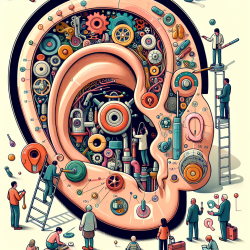Understanding Conductive Hearing Loss and Cochlear Tuning
Conductive hearing loss (CHL) during development has been a topic of significant interest, particularly regarding its impact on the auditory system. A recent study titled Conductive hearing loss during development does not appreciably alter the sharpness of cochlear tuning provides valuable insights into this area. As practitioners in the field of special education and therapy services, understanding these findings can enhance our approach to supporting students with hearing impairments.
The Study in a Nutshell
The research conducted by Ye, Ihlefeld, and Rosen (2021) aimed to explore the long-term effects of developmental CHL on the peripheral auditory system. Using a model involving gerbils, the study investigated whether CHL affects cochlear tuning and synapse integrity. The findings revealed that while developmental CHL can cause minor synaptopathy, it does not significantly alter the sharpness of cochlear tuning.
Key Takeaways for Practitioners
Here are some practical insights from the study that can be applied in educational and therapeutic settings:
- Focus on Central Auditory Changes: The study suggests that perceptual deficits associated with CHL are primarily due to changes in the central auditory system rather than peripheral alterations. This highlights the importance of interventions targeting central auditory processing.
- Early Detection and Intervention: Since CHL can lead to central auditory changes, early detection and intervention are crucial. Implementing auditory training programs and therapies that enhance central auditory processing can be beneficial.
- Comprehensive Assessment: While cochlear tuning remains largely unaffected, practitioners should conduct comprehensive assessments that include central auditory processing evaluations to identify potential deficits.
- Collaboration with Audiologists: Working closely with audiologists can ensure that students receive appropriate hearing assessments and interventions tailored to their specific needs.
Encouraging Further Research
While the study provides valuable insights, it also opens avenues for further research. Practitioners are encouraged to explore the following areas:
- Longitudinal Studies: Conducting longitudinal studies to track the progression of auditory changes in individuals with CHL can provide deeper insights into the long-term effects.
- Impact of Interventions: Researching the effectiveness of various interventions on central auditory processing in individuals with CHL can help refine therapeutic approaches.
- Cross-Species Comparisons: Comparing findings across different species can enhance our understanding of CHL's impact on the auditory system.
Conclusion
The study by Ye et al. (2021) offers a nuanced understanding of how developmental CHL affects the auditory system. By focusing on central auditory changes and implementing targeted interventions, practitioners can better support students with hearing impairments. For those interested in delving deeper into the research, the original paper can be accessed here: Conductive hearing loss during development does not appreciably alter the sharpness of cochlear tuning.










